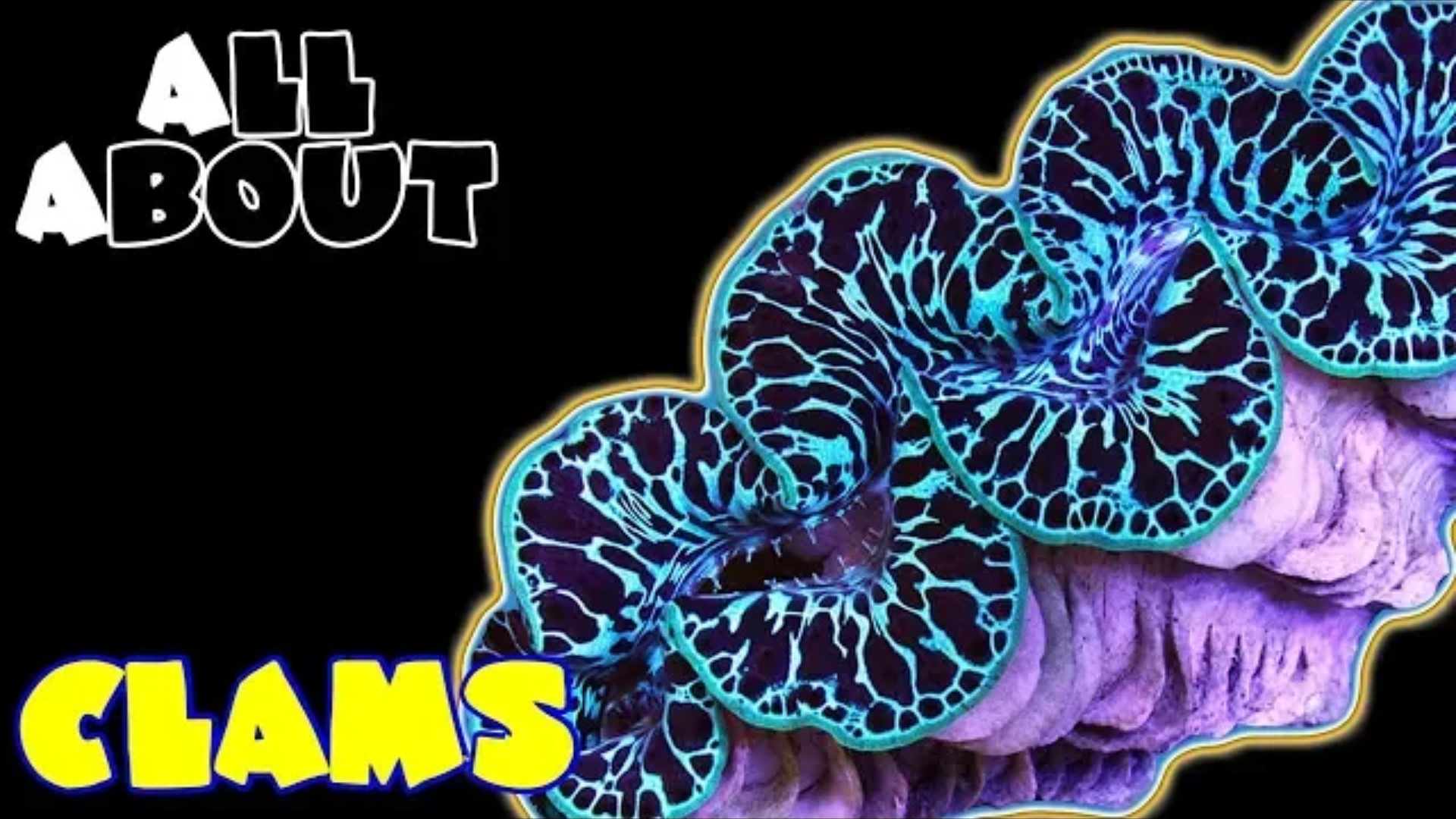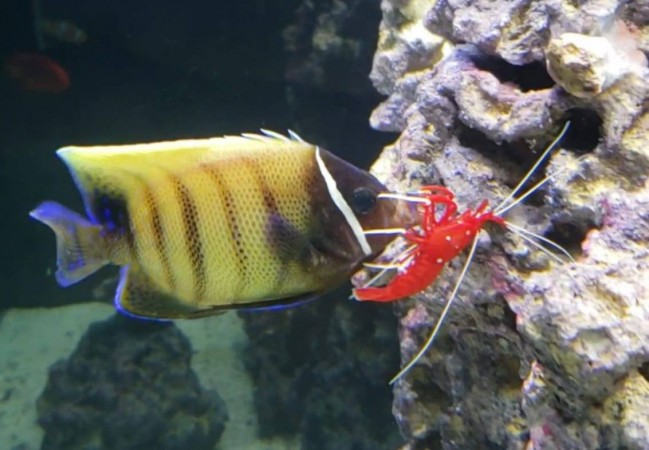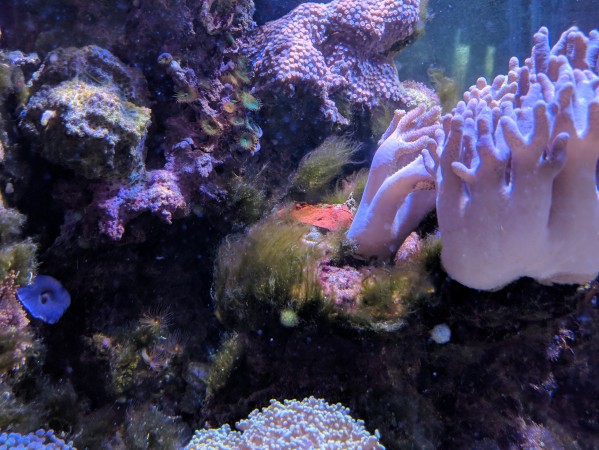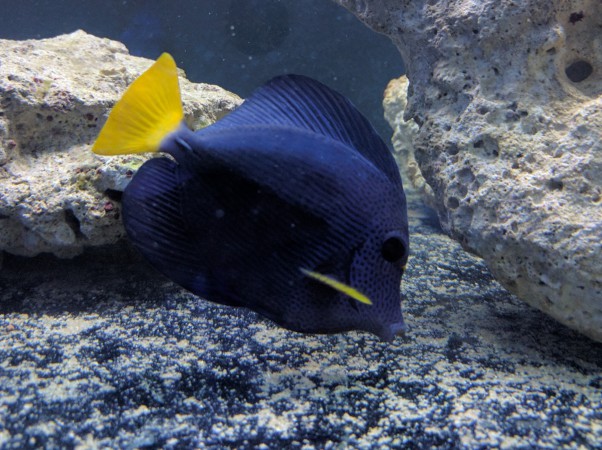- Name:
Maxima Clam, 1st Grade Blue
(View AKA's) - Family: Tridacnidae
- Species: Clam
- Scientific Name: Tridacnidae

General info about Maxima Clam, 1st Grade Blue
The Maxima Clam is one of the most visually breathtaking specimens available for the home aquarium. Its mantle contains luminescent, electric, and vibrant blue and purple hues. These are incredibly high-quality clams that will unequivocally inject your tank with color and charm. While the beauty alone encourages an impulse buy, the conscientious aquarist is best to do his or her homework before buying a maxima clam. While clams have a reputation for being hard to keep, the reality is that they are fairly hardy if kept in the proper environment. To add icing to the cake, clams actually help stabilize and improve water quality in a well-maintained reef.
The Maxima Clam is probably the most widely recognized species of the giant clams, with its beautiful mantle and rich variety of vivid colorations. Its shell may reach a width of up to 12 inches, though in the wild Maxima clam's have reached over 16 inches. It is the third largest giant clam following its cousins, the massive Gigas Clam, Tridacna gigas which reaches over 3 feet in length, and the Derasa Clam, Tridacna Derasa. Even though Maxima's can grow large, they do it at a much slower rate. On average this clam will only grow .08 to 1.6 inches per year, rather than the 4" per year seen with the for-mentioned two big fellows. To reach a 14" length will take a Maxima clam 50 to 60 years. Maxima Clams are also known to live together in great congregations in the wild in shallow areas of the reef where the sunlight is very strong.
When placing your maxima into the tank, do not put it in a tight crevice. This may prevent it from opening fully, or if it moves too much, it can fall behind the rock work. If putting them in a hole in the rock work, keep excess detritus out by periodically using a turkey baster or power head. If you have plenty of light on the substrate, placing them on a flat rock below the sand is best. Put a flat rock on the bottom glass of the tank and the clam on top of that. That helps to stabilize them and if you have to move them, the small rock makes it easier. Fill in the area with sand, as much as half way up the clam, to keep their byssal opening blocked off. This helps prevent pests from attacking them through the opening.
The vast majority of Maxima Clam available in the aquarium trade are cultured on land-based clam farms in the Central and South Pacific. Maxima Clams are found in an endless variety of colors and patterns, and these clams are graded for size, their intensity of coloration, and how complex their patterns are, and then priced accordingly. Larger clams that have the most intense coloration and intricate patterns are much more expensive.
Maxima Clams can be identified by having a more elongated shell that lacks symmetry, with narrowly spaced scutes or scallops on the upper portions of each side of their hinged shells. Like some other members of its genus, Maxima clams will arrive either unattached or attached to a small piece of rock or substrate. They will normally attach to a solid surface within a day or so of being introduced into the aquarium, so keep in mind that their first placement should be considered permanent. Never forcibly remove an attached clam from the substrate or rockwork, as lethal damage to their foot and other tissue will be inevitable. As a last resort, to remove a clam from a hard surface gently cut each byssal thread with a razor blade as close to the attachment point of the rock or solid surface, making sure not to slice or damage any tissue.
They should be kept at least 55-gallon tanks but preferably much bigger water volumes for water parameter is recommended for stability. Live rock is necessary and sand is preferred if they will be on the substrate. A mature tank is also important. The tank should be at least 6 months old from the time of adding that last piece of live rock. Once you see Coralline algae growing (that cool pink and purple hard algae) you know your tank is doing well and ready for your clam.
Maintaining a normal tropical reef temperature with less than two degrees of daily fluctuation is ideal, but it is absolutely essential to make sure the temperature never exceeds 82-degrees Fahrenheit. A normal reef pH is recommended, again with consistency being emphasized, but the aquarist keeping maxima clams should never allow the pH to exceed 8.4. Too high a temperature or pH will have a rapid, negative impact on maxima clams and must be avoided at all cost. Proper water chemistry is very important as well, and they will thrive when calcium levels of 380- 450 mg/L, an alkalinity level of 8-11 dKH, and a magnesium level of 1280-1350 ppm are maintained.
It is recommended that metal halide lighting is used in the reef aquarium to provide this species with enough lighting intensity to thrive. The Maxima Clam should also be placed where it will receive a steady moderate water flow as well. In the home aquarium, the Maxima Clams require intense lighting to thrive as they contain the symbiotic algae called zooxanthellae and receive the majority of their nutrition from the light through photosynthesis. Smaller Maxima Clam that is 2" or less in size are much more sensitive to very intense lighting as their membrane is much thinner than larger specimens. For this reason, care should be taken to properly photo-adapt them to the existing reef aquarium lighting in a similar manner to newly introduced stony and soft corals. When adapting a new Maxima Clam to very intense lighting, it is ideal to set them on a small rock or in a plastic dish with coarse substrate at the bottom of the aquarium. Over time the clam can then be slowly moved up higher in the aquarium.
When it comes to water flow, these clams typically live where they're regularly exposed to strong currents and wave activity. So, they're quite used to strong, surging water motion. Thus, it's perfectly okay to expose them to a surging or turbulent flow, but putting a specimen in a spot where a pump blasts it with a strong, non-stop linear current is not recommended. Basically, what you need to avoid is putting a specimen anywhere that currents cause its mantle to fold upwards or over onto itself all the time or an even stronger flow that makes a specimen chronically retract its mantle. On the other hand, it's hard to have it too slow as long as the water constantly flows over and around them.
They are peaceful in general. Don't keep them with tank mates that will pick at their mantles like hermit crabs and certain fish species that might pick at them such as dwarf saltwater angelfish and large saltwater angelfish. Also, avoid placing the clam too near to stinging corals, particularly those with long sweeper tentacles, and be sure that none of your corals shade out the clam as they grow.
Maxima clams are relatively easy to care for - especially if introduced into a stable aquarium environment. It is important to slowly acclimate clams to lighting and to avoid areas of the aquarium where the clam will be constantly hit by a water pump. Overall, the Maxima Clam is hardy, simply gorgeous and would be a welcomed addition to any home aquarium.
Maxima Clam, 1st Grade Blue Diet & Nutrition
Maxima clams are omnivores. Nutrition is obtained through filter-feeding of phytoplankton, zooplankton, and detritus along with lighting and the marine algae, zooxanthellae. Clams under 4 inches need daily feedings of phytoplankton. It is suggested that they are fed micro-foods designed for filter feeders, especially when small. Once they are older they will still benefit from phytoplankton foods fed on a regular schedule in an aggressively skimmed tank. With plenty of fish present, direct feeding is not as critical once they are over 4" long. When there is a good fish population, most clams fulfill their nutritional requirements by filter feeding and absorbing dissolved organic compounds from the water.
Although zooxanthella symbiotic algae provide most of their nutritional requirements however supplemental feedings of phytoplankton cultures can be provided. There are several products available for feeding clams. Turn off water flow and using a turkey baster or similar feeding device carefully squeeze the food out a few inches away from the mantle and let the food drift down to them. Sometimes this causes them to clench up. If you have trouble doing it that way, cut the bottom out of a clean 2 liter soda bottle (or milk jug depending on the size of the clam), place the bottle over the clam and while holding the bottle in place with one hand, administer the food to the clam with the other hand. Hold the bottle in place for a minute or two.
Breeding & Spawning Maxima Clam, 1st Grade Blue
Beginning life as a tiny fertilized egg, the small giant clam hatches within 12 hours, becoming a free-swimming larva. This larva then develops into another, more developed, larva which is capable of filter-feeding. At the third larval stage, a foot develops, allowing the larva to alternately swim and rest on the substrate. After eight to ten days, the larva metamorphoses into a juvenile clam, at which point it can acquire zooxanthellae and function symbiotically. The juvenile matures into a male clam after two or three years, becoming a hermaphrodite when larger (at around 5 inches in length). Reproduction is stimulated by the lunar cycle, the time of day, and the presence of other eggs and sperm in the water. Hermaphroditic clams release their sperm first followed later by their eggs, thereby avoiding self-fertilization.
Maxima Clam, 1st Grade Blue Origin
It is found in the oceans surrounding east Africa, India, China, Australia, Southeast Asia, the Red Sea and the islands of the Pacific.
Caution with Maxima Clam, 1st Grade Blue
They will attach to live rocks or nestle into sandy substrates in your aquarium and should not be forcibly removed from that spot.
The Maxima Clam should be housed with intense lighting to bring out their best colors and provide them nutrients through algae that live inside through photosynthesis.
Acclimating Maxima Clam, 1st Grade Blue
Slowly acclimate the clam to your water conditions (drip acclimatization is best, over the course of around an hour) and then place the clam as low down in the tank as possible, gradually moving it higher over 2 week time periods. It is important that it is not moved repeatedly over less a period of time unless you absolutely have to. Clams have a lot of trouble adapting to changes in lighting and current as it is, and moving them over and over again in shorter time periods can prove very stressful.
Original Detail
| Name | Species | Family | Scientific Name | More Detail | Added by |
|---|---|---|---|---|---|
| Maxima Clam, 1st Grade Blue | Clam | Tridacnidae | Tridacnidae | The Maxima Clam is one of the most visually breathtaking specimens available for the home aquarium. Its mantle contains luminescent, electric, and vibrant blue and purple hues. These are incredibly high-quality clams that will unequivocally inject your tank with color and charm. While the beauty alone encourages an impulse buy, the conscientious aquarist is best to do his or her homework before buying a maxima clam. While clams have a reputation for being hard to keep, the reality is that they are fairly hardy if kept in the proper environment. To add icing to the cake, clams actually help stabilize and improve water quality in a well-maintained reef. The Maxima Clam is probably the most widely recognized species of the giant clams, with its beautiful mantle and rich variety of vivid colorations. Its shell may reach a width of up to 12 inches, though in the wild Maxima clam's have reached over 16 inches. It is the third largest giant clam following its cousins, the massive Gigas Clam, Tridacna gigas which reaches over 3 feet in length, and the Derasa Clam, Tridacna Derasa. Even though Maxima's can grow large, they do it at a much slower rate. On average this clam will only grow .08 to 1.6 inches per year, rather than the 4" per year seen with the for-mentioned two big fellows. To reach a 14" length will take a Maxima clam 50 to 60 years. Maxima Clams are also known to live together in great congregations in the wild in shallow areas of the reef where the sunlight is very strong. When placing your maxima into the tank, do not put it in a tight crevice. This may prevent it from opening fully, or if it moves too much, it can fall behind the rock work. If putting them in a hole in the rock work, keep excess detritus out by periodically using a turkey baster or power head. If you have plenty of light on the substrate, placing them on a flat rock below the sand is best. Put a flat rock on the bottom glass of the tank and the clam on top of that. That helps to stabilize them and if you have to move them, the small rock makes it easier. Fill in the area with sand, as much as half way up the clam, to keep their byssal opening blocked off. This helps prevent pests from attacking them through the opening. The vast majority of Maxima Clam available in the aquarium trade are cultured on land-based clam farms in the Central and South Pacific. Maxima Clams are found in an endless variety of colors and patterns, and these clams are graded for size, their intensity of coloration, and how complex their patterns are, and then priced accordingly. Larger clams that have the most intense coloration and intricate patterns are much more expensive. Maxima Clams can be identified by having a more elongated shell that lacks symmetry, with narrowly spaced scutes or scallops on the upper portions of each side of their hinged shells. Like some other members of its genus, Maxima clams will arrive either unattached or attached to a small piece of rock or substrate. They will normally attach to a solid surface within a day or so of being introduced into the aquarium, so keep in mind that their first placement should be considered permanent. Never forcibly remove an attached clam from the substrate or rockwork, as lethal damage to their foot and other tissue will be inevitable. As a last resort, to remove a clam from a hard surface gently cut each byssal thread with a razor blade as close to the attachment point of the rock or solid surface, making sure not to slice or damage any tissue. They should be kept at least 55-gallon tanks but preferably much bigger water volumes for water parameter is recommended for stability. Live rock is necessary and sand is preferred if they will be on the substrate. A mature tank is also important. The tank should be at least 6 months old from the time of adding that last piece of live rock. Once you see Coralline algae growing (that cool pink and purple hard algae) you know your tank is doing well and ready for your clam. Maintaining a normal tropical reef temperature with less than two degrees of daily fluctuation is ideal, but it is absolutely essential to make sure the temperature never exceeds 82-degrees Fahrenheit. A normal reef pH is recommended, again with consistency being emphasized, but the aquarist keeping maxima clams should never allow the pH to exceed 8.4. Too high a temperature or pH will have a rapid, negative impact on maxima clams and must be avoided at all cost. Proper water chemistry is very important as well, and they will thrive when calcium levels of 380- 450 mg/L, an alkalinity level of 8-11 dKH, and a magnesium level of 1280-1350 ppm are maintained. It is recommended that metal halide lighting is used in the reef aquarium to provide this species with enough lighting intensity to thrive. The Maxima Clam should also be placed where it will receive a steady moderate water flow as well. In the home aquarium, the Maxima Clams require intense lighting to thrive as they contain the symbiotic algae called zooxanthellae and receive the majority of their nutrition from the light through photosynthesis. Smaller Maxima Clam that is 2" or less in size are much more sensitive to very intense lighting as their membrane is much thinner than larger specimens. For this reason, care should be taken to properly photo-adapt them to the existing reef aquarium lighting in a similar manner to newly introduced stony and soft corals. When adapting a new Maxima Clam to very intense lighting, it is ideal to set them on a small rock or in a plastic dish with coarse substrate at the bottom of the aquarium. Over time the clam can then be slowly moved up higher in the aquarium. When it comes to water flow, these clams typically live where they're regularly exposed to strong currents and wave activity. So, they're quite used to strong, surging water motion. Thus, it's perfectly okay to expose them to a surging or turbulent flow, but putting a specimen in a spot where a pump blasts it with a strong, non-stop linear current is not recommended. Basically, what you need to avoid is putting a specimen anywhere that currents cause its mantle to fold upwards or over onto itself all the time or an even stronger flow that makes a specimen chronically retract its mantle. On the other hand, it's hard to have it too slow as long as the water constantly flows over and around them. They are peaceful in general. Don't keep them with tank mates that will pick at their mantles like hermit crabs and certain fish species that might pick at them such as dwarf saltwater angelfish and large saltwater angelfish. Also, avoid placing the clam too near to stinging corals, particularly those with long sweeper tentacles, and be sure that none of your corals shade out the clam as they grow. Maxima clams are relatively easy to care for - especially if introduced into a stable aquarium environment. It is important to slowly acclimate clams to lighting and to avoid areas of the aquarium where the clam will be constantly hit by a water pump. Overall, the Maxima Clam is hardy, simply gorgeous and would be a welcomed addition to any home aquarium. |
Admin |
Changed by users
| Submitted Date | Submitted By | Status | Action |
|---|---|---|---|
| 2019-01-21 19:50:18 | merve kutsal | Approved | Edit |
| 2019-01-21 19:45:06 | merve kutsal | Approved | Edit |
| 2019-01-21 18:51:05 | merve kutsal | Approved | Edit |
| 2019-01-21 17:02:17 | merve kutsal | Approved | Edit |
| 2019-01-21 16:10:19 | merve kutsal | Approved | Edit |
| 2019-01-10 10:41:14 | merve kutsal | Approved | Edit |





